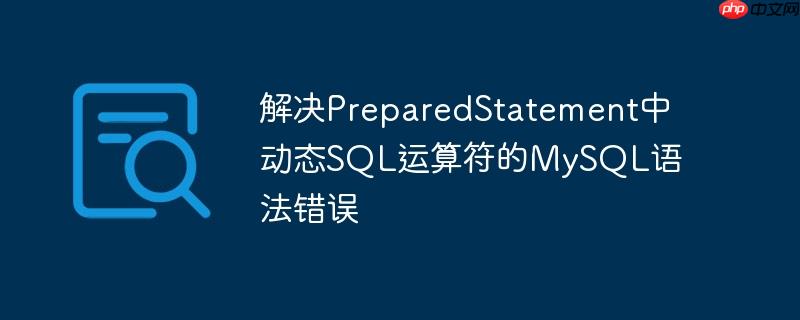
在使用JDBC进行数据库操作时,PreparedStatement是执行SQL查询的首选方式,它能有效防止SQL注入并提高性能。然而,开发者有时会遇到com.mysql.jdbc.exceptions.MySQLSyntaxErrorException,尤其是在尝试构建动态查询时。一个常见的错误场景是试图将SQL运算符(如>=、<=、=)作为参数绑定到PreparedStatement的占位符(?)中。
例如,原始代码尝试构建如下SQL:
String sql = "SELECT * FROM total WHERE totals ? ?;"; PreparedStatement stmt = con.prepareStatement(sql); stmt.setString(1,signString); // 尝试绑定运算符 stmt.setString(2,amount); // 绑定值
这会导致MySQLSyntaxErrorException: You have an error in your SQL syntax; check the manual that corresponds to your MariaDB server version for the right syntax to use near ''1'' at line 1。错误信息清晰地指出SQL语法存在问题,特别是在WHERE子句中,因为它将运算符视为字符串字面量'='或'>=',而不是实际的SQL运算符。
PreparedStatement的占位符(?)设计初衷是用于绑定SQL语句中的值(values)。这意味着你可以用它来替换查询条件中的具体数据,例如:
JDBC驱动在执行PreparedStatement时,会将这些占位符替换为实际的值,并确保这些值被正确地转义和引用,从而防止SQL注入。
然而,占位符不能用于替换SQL语句的结构性元素,包括:
当尝试将运算符(例如>=)绑定到占位符时,数据库会将其视为一个字符串字面量,而非一个操作符,从而导致语法错误。例如,WHERE totals ? ?在绑定后可能变成WHERE totals '>=' '100',这显然不是一个合法的SQL条件。
解决此问题的正确方法是:对于动态的SQL运算符,使用字符串拼接的方式将其插入到SQL查询字符串中;而对于动态的数值,则继续使用PreparedStatement的参数绑定机制。
以下是修正后的代码示例:
import java.sql.Connection;
import java.sql.DriverManager;
import java.sql.PreparedStatement;
import java.sql.ResultSet;
import java.sql.SQLException;
public class DynamicSqlOperatorExample {
public static void main(String[] args) {
// 假设type和amount是从其他地方获取的动态值
int type = 1; // 1: greater, 2: lesser, 3: equal
String amount = "100";
Connection con = null;
PreparedStatement stmt = null;
ResultSet rs = null;
try {
Class.forName("com.mysql.cj.jdbc.Driver"); // 注意:新版本MySQL驱动类名为com.mysql.cj.jdbc.Driver
con = DriverManager.getConnection("jdbc:mysql://localhost:3306/jsupermarket", "root", "");
String signString = "";
if (type == 1) { // greater
signString = ">=";
System.out.print("1 selected \n");
} else if (type == 2) { // lesser
signString = "<=";
System.out.print("2 selected \n");
} else if (type == 3) { // equal
signString = "=";
System.out.print("3 selected \n");
}
// 核心修改:将运算符直接拼接进SQL字符串,而值仍然使用占位符
// 注意:SQL语句末尾不应包含分号
String sql = "SELECT * FROM total WHERE totals " + signString + " ?";
stmt = con.prepareStatement(sql);
stmt.setString(1, amount); // 只有值才通过占位符绑定
rs = stmt.executeQuery();
// 处理结果集
while (rs.next()) {
// 示例:打印total列的值
System.out.println("Found total: " + rs.getString("totals"));
}
} catch (ClassNotFoundException e) {
System.err.println("JDBC Driver not found: " + e.getMessage());
} catch (SQLException e) {
System.err.println("SQL Error: " + e.getMessage());
e.printStackTrace();
} finally {
// 关闭资源
try {
if (rs != null) rs.close();
if (stmt != null) stmt.close();
if (con != null) con.close();
} catch (SQLException e) {
System.err.println("Error closing resources: " + e.getMessage());
}
}
}
}关键改动点:
通常情况下,直接使用字符串拼接来构建SQL查询是强烈不推荐的,因为它极易导致SQL注入漏洞。如果拼接的字符串内容来源于用户输入,恶意用户可以注入额外的SQL代码来篡改查询逻辑或窃取数据。
然而,在上述示例中,signString的值(>=, <=, =)是完全由程序内部逻辑控制的,不接受任何外部用户输入。这意味着,恶意用户无法通过操纵signString来注入恶意的SQL代码。因此,在这种特定场景下,使用字符串拼接是安全的。
最佳实践:
MySQLSyntaxErrorException在PreparedStatement中尝试绑定运算符的根本原因在于对占位符用途的误解。占位符专为绑定值设计,而非SQL结构。通过将动态运算符与SQL字符串拼接,同时继续利用PreparedStatement绑定动态数值,可以有效解决此问题。在执行字符串拼接时,务必牢记SQL注入的风险,并确保所有拼接内容都经过严格的内部控制和验证,以维护应用程序的安全性。
以上就是解决PreparedStatement中动态SQL运算符的MySQL语法错误的详细内容,更多请关注php中文网其它相关文章!

每个人都需要一台速度更快、更稳定的 PC。随着时间的推移,垃圾文件、旧注册表数据和不必要的后台进程会占用资源并降低性能。幸运的是,许多工具可以让 Windows 保持平稳运行。

Copyright 2014-2025 https://www.php.cn/ All Rights Reserved | php.cn | 湘ICP备2023035733号